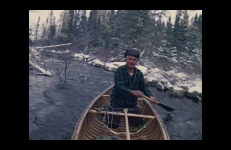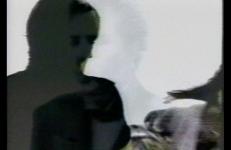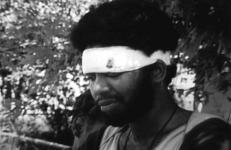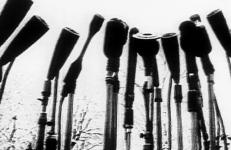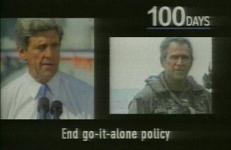Guided expertly by those who live on the land and driven by the pulse of the natural world, Mobilize takes us on an exhilarating journey from the far north to the urban south. Over every landscape, in all conditions, everyday life flows with strength, skill and extreme competence. Hands swiftly thread sinew through snowshoes. Axes expertly peel birch bark to make a canoe. A master paddler navigates icy white waters. In the city, Mohawk ironworkers stroll across steel girders, almost touching the sky, and a young woman asserts her place among the towers.
Found Footage
Since his early days in Ant Farm, Lord’s evocation of the automobile has been the car as avatar, as the spirit of America—that consummate combination of superior organized corporate technology and the pioneering triumph of the willful individual driver. Motorist is a 69-minute road picture in which the camera rides shotgun with TV actor Richard Marcus as he plays a drifting driver.
Moving Stories strings together scenes of passenger aircraft in flight. In this short study of the dramatic and narrative power of image and sound, Provost manipulates cinema language and reaches, though minimal means, a strong, emotionally loaded result. With a limited number of images, an absorbing soundtrack, and a suggestive story line, the viewer's imagination is stimulated to the maximum.
A five-minute video collaboration between Dani Leventhal and Steve Reinke.
A five-minute video collaboration between Dani Leventhal and Steve Reinke.
My Only Idol is Reality is a video work created from an excerpt of Season One of MTV’s The Real World. The piece uses repetition as a framework for abstraction — re-recording the video between
My TV Dictionary: The Drill is one of several video works Breder created by re-editing recorded footage from cable television movies. This video conveys the violent and sexist subtext of the 24/7 stream of cable television “and thus becomes a potent metaphor for our times” - Jon Hanhardt, 1987
There is no future in reproduction. I have no concern with any species extending itself through time. You think you have given birth to a baby, when really you have given birth to a bus driver, or tax collector. Instead I'm interested in the placenta, the real mother of us all, forgotten discarded. The softest machine, all lipids and blood, that blooms and rots like any vegetal/floral martyr. That umbilical cord did not connect you to your mother. It connected you to that most partial of objects — the placenta — part you, part mom, all martyr and garbage.
In a tape that stands out as one of the earliest examples of the use of appropriated television footage, Freed assembles a collage of images representing American media icons, from Mickey Mouse and Richard Nixon, to The Wizard of Oz and the Rolling Stones. Placing cartoon images next to images of the war in Vietnam, Freed creates an appropriately surreal vision of American culture, and begs the question whether an anthropologist of the future would be able to decipher the truth of the age from such a confused mix of representations.
No Damage is a composition made out of fragments from over 80 different feature and documentary films that show the architecture of New York City — its architectural presence as captured on film over eight decades. Lifted out of their original context and juxtaposed in groups, these scenes reveal their emotional implications: grandeur, glamour, the wake of modernism, post-modernism and, most recently, post 9/11 sentimentalism. A number of particular clips that resonate such emotions enter into a non-verbal discourse on age, status, functionality and aesthetics.
The archive is not a repository of cultural memory, but of dreams, a bank of dream material. Both memory and archive embrace death, but from contrary positions. The archive is a mausoleum that pretends to be a vast garden. Memory is an irradiated zoo in which the various animals are mutating extravagantly and dying slowly.
-- Steve Reinke
In 1985 the great soprano Leontyne Price sang the title role in Verdi’s Aida as her farewell opera. After the ‘O patria mia’ aria, the audience breaks into a four-minute applause. Oh My Homeland is the third in a series of minimal single shot 16mm films. It’s a film about representation, art, and material exchange. It’s a film about endings. It’s a film about identity, love, power, patriotism and the transcendent potential of art through the viewing of a face receiving adoration.
Introduces the audience to the rockin' talkin' pony, who provides musical accompaniment for a series of Texas country-dance lessons.
This title is also available on Ben Coonley: Trick Pony Trilogy.
Ouroboros: Music of the Spheres is Chapter 3 of Mysterium Cosmographicum.
"Positing a linear continuum, with 'nothing' at one end of the spectrum and 'something' at the other, at what point does 'nothing' become 'something?'"
Vice President Mike Pence eagerly plays cheerleader in chief for Donald Trump. In accepting the vice-presidential nomination in 2016, Pence proclaimed, “I'm a Christian, a conservative, and a Republican — in that order,” suggesting how we might understand his role. This ground-breaking, earth-shaking video begins with a pomp-ridden televised press conference, accompanied by uplifting music. Held early in 2017 at the White House Rose Garden, it showcased the president’s announced withdrawal from the historic Paris Climate Accord.
People enjoy my company connects the privatisation of telecommunications with techno-optimism, euphoria and online communication in the lead-up to the millennium.
The film explores the privatisation of the Irish state-owned telecommunications company Telecom Éireann from the viewpoint of shareholders communicating on early online forums. The event is contextualised within ideologies of technological emancipation in the pre-millennium period.
The Physical Impossibility of Life in the Mind of Someone Dead is Chapter 2 of Mysterium Cosmographicum.
I can’t live if living is without you, he said as his tear-stained cheek glistened in the glare of the klieg lights. Slowly, he tightened his finger around the trigger . . . .
The Picnic is a film made with found footage about a couple enjoying a beautiful day, food, sex, a blanket, long walks and a firearm.
This title is only available on Broad Daylight and Other Times: Selected Works of Kevin Jerome Everson.
Via Jonathan Pryce in elaborate costuming, Walt Disney’s Pirates of the Caribbean (2003) unwittingly sounded a clear and full-throated argument for the appropriation of so-called intellectual property, for the video remix/rework/quotation, practices and forms that would become ubiquitous on YouTube and its ilk a few short years later.
Playing Dead is a film about lying still to stay alive. A news reporter queries the survivor of a brutal attack.
This title is only available on Broad Daylight and Other Times: Selected Works of Kevin Jerome Everson.
Presidential candidates are sold like commercial products and naturally television is the ideal medium. Political Advertisement depicts the evolution of political ads over the last 44 years, beginning with Eisenhower in 1952 (which was an unqualified success), and continuing up to the most recent ad campaigns for Ross Perot, Bob Dole, and Bill Clinton in 1996.
Presidential candidates are sold like commercial products and naturally television is the ideal medium. Political Advertisement depicts the evolution of political ads over the last 44 years, beginning with Eisenhower in 1952 (which was an unqualified success), and continuing up to the most recent ad campaigns for Ross Perot, Bob Dole, and Bill Clinton in 1996.
Antonio Muntadas and Marshall Reese have been documenting the selling of the American presidency since 1984, and have expanded and updated the series with every election. Political Advertisement 2000 features ads from the 1950s up to the 2000 campaign. As Muntadas and Reese trace the development of the TV spot, what emerges is the political strategy and manipulative marketing techniques of the American televisual campaign process. Political Advertisement 2000 includes many rare spots, some never before seen.
Antonio Muntadas and Marshall Reese have been documenting the selling of the American presidency since 1984, and have expanded and updated the series with every election. Political Advertisement 2000 features ads from the 1950s up to the 2000 campaign. As Muntadas and Reese trace the development of the TV spot, what emerges is the political strategy and manipulative marketing techniques of the American televisual campaign process. Political Advertisement 2000 includes many rare spots, some never before seen.
The latest in Muntadas and Reese's series documenting the selling of the American presidency features political ads from the 1950s to ads from the 2004 campaigns, and highlights the development of the political strategy and marketing techniques of the TV campaign process.
Edited without commentary, the artists show an endless stream of candidates, from Eisenhower to Kerry, who are marketed like commercial products. As Muntadas and Reese trace the development of the campaign TV spot, what becomes apparent is a consistent sameness of political issues amid complex, changing visuals.




